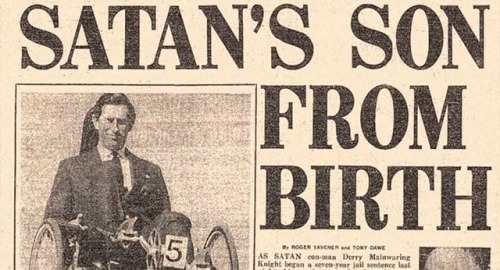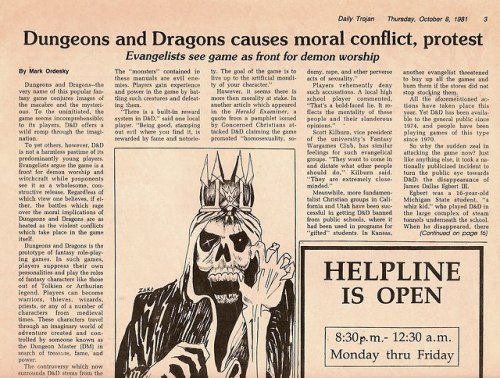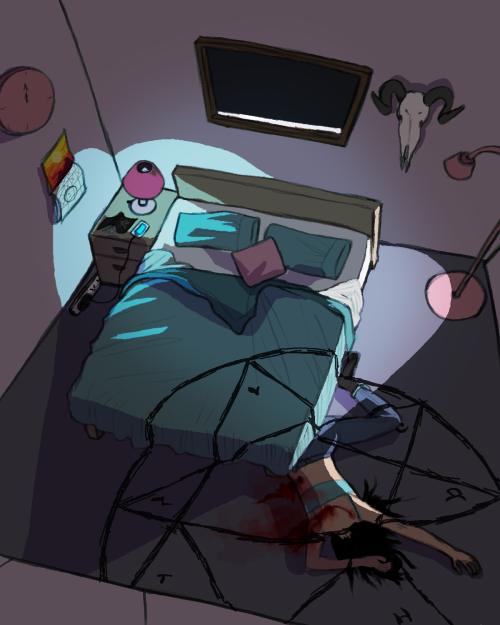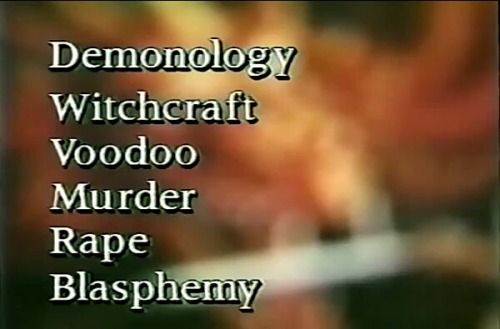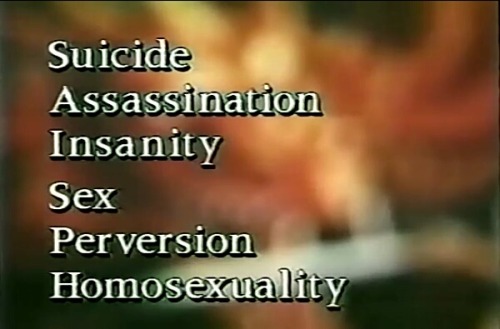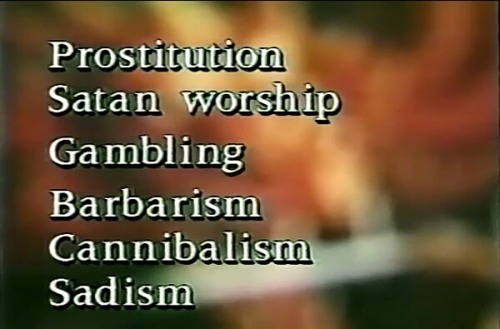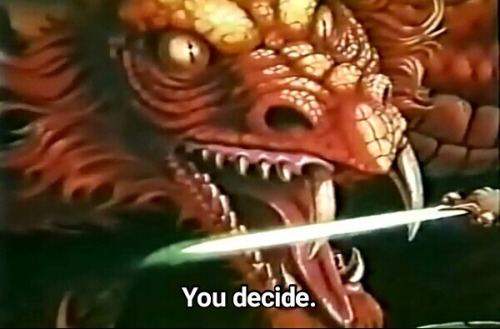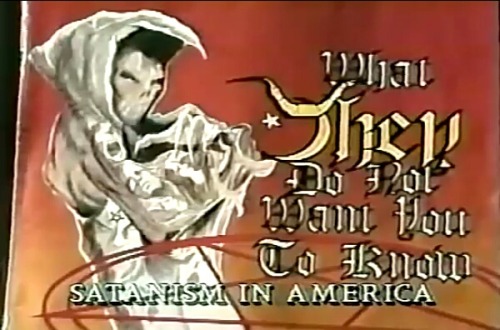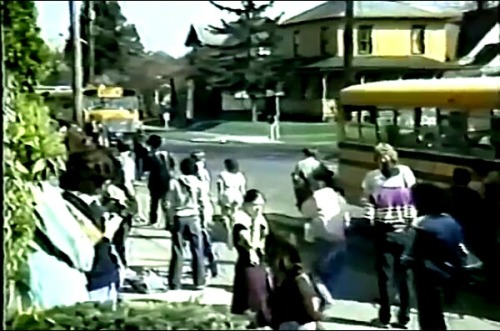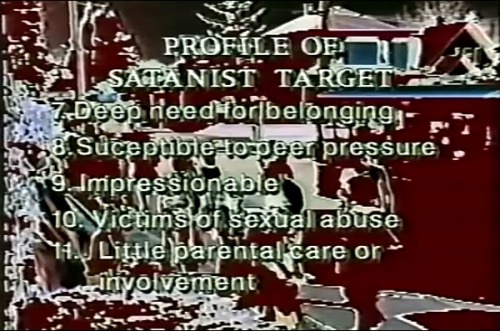#satanic panic
You must read this article in its entirety to understand how the blather of today’s SJW moralizing is no different than 80s conservatives fear mongering on how Satan was taking over our children, but I have taken out some excerpts I found interesting …
Moral Panic, Then and Now byBarrett Wilson
Writing in The Atlantic last year, Emily Yoffe made a compelling case that the trauma-focused approach of today’s therapists and activists evokes the recovered-memory hysteria of the 1980s; and that claims of a “rape culture” on campuses echoes the satanic panic that drove my sister out of our home. The piece echoed an equally brave 2014 article for The Nation, by JoAnn Wypijewski, who wrote: “These panics have shared features. Sex figures as a preternatural danger, emotion swamps reason, monsters abound, and protection demands any sacrifice.” …
During the time of satanic panic, fear was spread by the PMRC, by politicians, by GeraldoandOprah, and by well-meaning therapists and activists. The campus rape panic, similarly, is fed by the U.S. Department of Education (with its Title IX guidance of 2011), by Twitter hashtag campaigns, and by those same well-meaning therapists and activists. …
Some activists have gone so far as to prevent innovative musical artists from entering entire countries because of problematic content produced in the past. The Australian activist organization Collective Shout, for instance, lobbied successfully to ban Tyler, the Creator from entering Australia because his music contained references to rape and other misogynistic material. Its petition read:
The messages propogated [sic] in these lyrics pose particular risk to the Australian community by conveying the message that interpersonal conflict might be legitimately resolved through violence. Unfortunately this message still enjoys resonance in significant parts of our society which heightens the risk posed to women and children of his entry.
Compare those words to these:
Racial and sexual epithets, whether screamed across a street or camouflaged by the rhythms of a song, turn people into objects less than human—easier to degrade, easier to violate, easier to destroy.
That’s from Tipper Gore in 1990, when she was railing against rapper Ice-T and his contemporaries. Both Collective Shout and Gore relied on the idea that an artist’s choice of language can lead to violence. And both statements play on the idea that listeners are weak-minded and impressionable. …
The right-left pro-censorship alliance that Gore formed three decades ago has its modern equivalent in the Twitter era. Right-wing men’s rights advocates and hyper-progressives found common cause in an online shaming campaign targeting Canadian feminist Meghan Murphy, for instance, after she dared suggest that women born into their female bodies might have reason to see themselves differently from those born with penises. …
The tactics used by right-wing Twitter trolls such as Mike Cernovich to get James Gunn fired from Disney are identical to those used by the left to get Twitter troll Godfrey Elfwick de-platformed. Their crime was the same: tweeting controversial jokes. …
Today’s SJWs are no different than yesterday’s Conservative Christians. A big amen to Barrett Wilson on that (please click and read his full article).
End of story.

Mutilations of bodies. Cannibalism. Gang rape. That is what a video nasty is.” So said Graham Bright, the Conservative MP who introduced the Private Member’s Bill that was passed as the Video Recordings Act (VRA), 30 years ago yesterday. Giving statutory power to the British Board of Film Classification (BBFC), the act made it illegal to sell or supply a video that the board hadn’t examined and classified.
It effectively banned certain examples of exploitation and horror cinema which the media had labelled “video nasties”, and more to the point, helped quell the hysteria surrounding them. This had been fed by newspapers such as the Daily Mail, which, in July 1983, launched a campaign with the front-page headline “Ban video sadism now”, described the “Rape of our children’s minds”, and in a story headed “‘Taken over’ by something evil from the TV set”, suggested that a boy had been possessed by one such film.
Horror film-maker Jake West directed a comprehensive 2010 documentary about the pre-certification era, Video Nasties: Moral Panic, Censorship and Video- tape, and has now made a follow-up, Video Nasties: Draconian Days, timed to coincide with the anniversary of the VRA and dealing with its after effects. “You had the Daily Mail causing people to believe they were evil. And politicians, who needed to say that video was dangerous to get an act in place to regulate it, stoking the fear,” he says.
The first video cassette recorders (VCRs) went on sale in the UK in 1979, and by 1984 they could be found in a quarter of homes. But Hollywood reacted to this technological revolution in the same way as it would to internet file-sharing 20 years later. That’s to say, with horror. The head of the Motion Picture Association of America told a 1982 hearing: “The VCR is to the American film producer… as the Boston Strangler is to the woman home alone.”
Hollywood held back its biggest titles, and so an unregulated rental market was flooded with cheap imports: Italian zombie films and American slashers bought up and distributed by enterprising one or two-man operations. This was the sort of entrepreneurial enterprise of which the Tory government of the day was usually in favour. But Margaret Thatcher’s faith in free-market capitalism was matched only by a puritanical morality that titles such as The Evil Dead, I Spit on Your Grave and The Driller Killer were calibrated to offend.
Distributors of films without recognisable titles or famous stars had to resort to attention-grabbing marketing. The boxes featured wonderfully lurid artwork: frequently making promises to the gore-hungry that the films didn’t keep. In March 1982, distributor Go Video sent a copy of its release Cannibal Holocaust, along with a faux outraged letter, to the moral crusader Mary Whitehouse. It had wanted the free media coverage that a little bit of controversy brings, but what ensued was a full-scale moral panic.
The term “video nasty” was first used in a story in The Sunday Times in May 1982 with the headline “How high street horror is invading the home”. Responding to political pressure, the Obscene Publications Squad began raiding video rental shops. And in 1983, to save the police the trouble and the cost in overtime of watching the seized material, the Director of Public Prosecutions drew up a list of 72 films that it suspected might be in breach of the Obscene Publications Act. Titles that were found to be so were burned by the lorryload.
The VRA brought some legal clarity to an industry in chaos. But as has historically tended to be the case, prohibition had the opposite effect to the one intended, and the campaign against video nasties had made a lot of people want to see them all the more. Indeed, the DPP had provided a handy list of recommendations.
West is nostalgic about the era. “As much as I am opposed to censorship,” he says, “it gave my generation of film viewers a thrilling sense of the forbidden. That thrill is gone from cinema now.”
Horror fans set up clubs, wrote fanzines, and traded tapes at film fairs and in classified ads. These third- or fourth-generation copies of tapes smuggled in from the Continent had muffled sound and blurry images. “But that was very forgiving of bad special effects. And your imagination took you the rest of the way.”
“We know no spectacle so ridiculous as the British public in one of its periodical fits of morality,” wrote Lord Macaulay in 1830, and West is inclined to agree. “Horror fans were branded as weirdos, but we weren’t. We were just enjoying cinema. We weren’t being depraved or turning into zombified killers. The reaction of the media was clearly ridiculous. That was the first time in our lives as teenagers that we began to question what we were being told.”
No other country had the same conniptions at the arrival of video technology. “One of the problems with the British,” West says, “is that they do like a bit of a nanny state. There was also a very British class element.” After a screening of the Texas Chainsaw Massacre for British Film Institute members, the chief censor, James Ferman, in a perfect echo of the prosecutor in the Lady Chatterley obscenity trial, said: “It’s all right for you middle-class cinéastes to see this film, but what would happen if a factory worker in Manchester happened to see it?”
We also have an island mentality, West says: “A majority on the list were foreign films, so there was also the insular view that we needed protection from outside forces.”
Almost all of the nasties have since had UK DVD releases, and while a handful remain potent – The Evil Dead, Last House on the Left, Cannibal Holocaust – the majority are tame, trashy or downright inept. Rewatching them today, the 1980s hysteria seems laughable. But the nasties saga should be taken seriously as a reminder that moral panics provide distractions and simplistic explanations for difficult social problems, and so laws made in response tend to be arbitrary or draconian.
While the VRA remains in place and the BBFC retains its statutory power, the internet has made censorship increasingly untenable. It would be sad to have to look back at the present from a less libertarian future in which the internet had been made a scapegoat and restricted the way video once was. Thankfully, says West: “With the access to communications, nowadays we have a voice, and it’s a lot harder for them to get away with that sort of thing.”
Some of the victims of mass hysteria over satanic ritual abuse are still serving sentences.

Written by Aja Romano
The latter half of 2016 has witnessed an interesting convergence of several elements associated with one of the most famous, prolonged mass media scares in history: the “Satanic Panic” that troubled the US throughout the 1980s and into the early 1990s.
Most people, if they know of the Satanic Panic, know of it due to satanic ritual abuse, a rash of false allegations made against daycare centers in the ’80s. But there are lots of threads that contribute to Satanic Panic, and they can be seen running through a handful of recent social and cultural events: the wave of clown scares throughout the country; the new TV seriesbased on The Exorcist; the weekend release of Ouija 2: Origin of Evil; and the October 23 death of fire-and-brimstone evangelical tract writer Jack Chick. All of these events feel lifted straight from this darker era of American culture, when fear of demons and strangers practicing dark occult things seemed to lurk in the heart of every neighborhood.
At its core, satanic ritual abuse claims relied on overzealous law enforcement, unsubstantiated statements from children, and above all, coercive and suggestive interrogation by therapists and prosecutors. Some of the defendants are still serving life sentences for crimes they probably didn’t commit—and most likely didn’t even happen in the first place.
Do all these revived elements of Satanic Panic mean we’re seeing a resurgence of the trend? Not exactly; it could all be chalked up to coincidence. But a look at the rise of this bizarre period in US history offers another possible explanation: Satanic Panic never truly went away to begin with.
The 1970s: the Rise of occultism, Satanism, and evangelical fear
A number of factors contributed to the increased interest in, and fear of, the occult during the late 1960s and 1970s. The Manson cult’s operation in the late ‘60s culminated in a string of mass murders in the summer of 1969 that shocked the nation and put organized ritualistic killing on the brain.
That same year, organist turned occultist Anton LaVey published his philosophical treatise The Satanic Bible, which plagiarized several sources and mostly regurgitated earlier philosophies of self-actualization and self-empowerment from writers like H.L. Mencken and Ayn Rand. Nevertheless, it became the seminal work of modern Satanism and the key text for the Church of Satan, a group LaVey had officially founded in 1966.
Accompanying the rise of Satanism as a recognized practice was the 1971 publication of William Peter Blatty’s bestselling novel The Exorcist and its blockbuster 1973 film adaptation. With its claims of being based on a true story, The Exorcist profoundly impacted America’s collective psyche regarding the existence of demons, and single-handedly transformed the popular Ouija board from a fun, harmless parlor game into a malevolent device capable of inducing spirit possession, demonic infestation, or other paranormal activity.
Then came the 1972 publication of Satan Seller. A fabricated memoir, ultimately discreditedafter 20 years, by self-proclaimed Christian evangelist Mike Warnke, Satan Seller recounted a childhood and young adulthood Warnke claimed was spent in intense satanic worship. The memoir claimed that he served as a satanic high priest and was engaged, among other things, in ritualistic sex orgies. (Remember that, it’ll be important later.)
The publication of LaVey’s Satanic Rituals that same year reinforced the idea that dark occult rituals had become a routine part of life for many Americans. And though it had no connections to Satanism or traditional occult religion, near the end of the decade, the Jonestown massacre gave the world another indelible example of what violence in a cult looked like.
The ’70s saw the rise of other self-proclaimed former Satanists who insisted that the world was being run by ritualistic satanic witch cults: John Todd, Hershel Smith, and David Hanson. Including Warnke, all four men grew up in Southern California and seemed to rise from the still-smoldering ashes of the Manson cult to declare that the world was full of dark occult symbols and far-reaching satanic conspiracies. All of them claimed to have conversion experiences that made their stories appealing to Christians.
And all of them were linked to the emerging fundamentalist Christian right. Todd was supported by Christian tract maker Jack Chick, who used his fabricated claims as the basis for numerous comic-style pamphlets advocating against Satanism. Warnke spent over a decade posing as an “expert” in Satanism for the fundamental evangelical Christian community, passing off much of his made-up childhood as a template for how “real” Satanism worked.
The growing fascination with the occult also coincided with the rise of a number of extremely well-publicized serial killing cases that took place in the ’70s: the Zodiac killer and the Alphabet Killer, both of whom utilized ritualistic patterns in their killings, neither of whom were ever caught; Ted Bundy;John Wayne Gacy; the Hillside Stranglers; and David Berkowitz, a.k.a. the Son of Sam, who sparked a mass panic during the summer of 1977 in New York City.
Many of these well-publicized serial killers maintained an image of having the upper hand in some way: The Zodiac Killer and Berkowitz wrote taunting letters to the press and police; Bundy escaped from prison and immediately resumed his terrifying killing sprees; John Wayne Gacy hid his evil under the most banal of disguises, a friendly clown who performed for children. As the brazen anarchy associated with these kinds of high-profile killings grew, so did public fear.
In a 2005 book about that fateful New York summer, Ladies and Gentlemen, The Bronx is Burning, author Jonathan Mahler writes of the impact that Son of Sam had on the media: “The frenzied [media] coverage fanned the growing sense of fear; the growing sense of fear fanned the frenzied coverage.” Mahler’s observation about the media fueling this mass panic would ring true well into the next decade, when heightened religious fears and stranger danger coalesced into a new breed of mass hysteria.
The 1980s: Stranger Danger and a growing fear of your own neighborhood
Although it was a time of economic growth and financial prosperity, the Reagan Era was also a time of unease centered on population growth, urbanization, and the rise of the double-income family model, which necessitated a sharp rise in the need for daycare services. As a result, anxiety about protecting the nuclear family from the unknown dangers of this new era was high: The ’80s saw the rise of AIDS scares, kidnap victims’ faces appearing on milk cartons, the mass panic surrounding the 1982 Tylenol murders, trick-or-treat scares (the nation’s lone Halloween candy killer, Ronald Clark O’Brien, received a highly publicized execution in 1984), and the first wave of reports of scary killer clowns attempting to prey on children.
Each of these outbreaks of social unrest signaled Americans’ growing alarm over “stranger danger” and the fear that a terrifying, unknown evil could be lurking right around the corner.
RELATED
The great clown panic of 2016 is a hoax. But the terrifying side of clowns is real.
Through it all, Christian fundamentalism and the rise of a literal belief in angels and devils was on the rise. Fundamentalist preachers like Jerry Falwell and his Moral Majority, founded in 1979, gained prominence across the country, passing along a literal fire-and-brimstone style of Christianity. Anti-occult crusaders like Pat Pulling, who believed her son committed suicide because of an evil Dungeons and Dragons curse, crusaded against roleplaying games as dangerous and demonic, backed by occult fear-mongering from Chick and his Chick Tracts.
The evangelical movement wasn’t alone in its growing occult obsession and fear-mongering. The media, too, played a huge role in stoking the public’s fear and fueling misconceptions surrounding occult practices. In 1988, Geraldo Rivera’s lurid documentary Devil Worship: Exposing Satan’s Underground became the highest-rated televised documentary to air up to that point. A 1991 20/20 episode famously (and for many viewers terrifyingly) televised an official Roman Catholic exorcism. Evangelical documentaries like Hell’s Bells attempted to tie rock music to the occult, while “Christian fantasy” like that of bestselling author Frank Perettitransformed real-world social issues into matters of angelic and demonic warfare.
With all of this parallel emphasis on fearing strangers in your neighborhood and Satan in your home, a collision of the two was practically inevitable.
The rise of satanic ritual abuse
In 1980, a since-discredited memoir called Michelle Remembers became a scandalous bestseller based on its purported detailing of a childhood spent undergoing a wealth of shocking occult sexual abuse. Its co-authors were controversial psychologist Lawrence Pazder and his wife Michelle Smith, a former patient Pazder claimed to have regressed into childhood through hypnosis. Pazder purportedly helped Smith uncover memories of past abuse at the hands of members of the Church of Satan, which Pazder insisted was older than LaVey’s group by several centuries.
Almost from the moment of Michelle Remembers’publication, its claims and allegations were repeatedly and thoroughly debunked. However, thanks to widespread and credulous media praise, Pazder and Smith were able to double down on their story, and Pazder became seen as an expert in the arena of what would come to be called satanic ritual abuse.
Despite the wild implausibility and unverifiable foundation of its stories of grisly abuse and sex orgies, Michelle Remembers was presented during the ’80s and early ’90s as a textbook for legal professionals and other authorities. It also spawned numerous copy-cat memoirs like 1988’s Satan’s Underground, all equally false, which embellished and mainstreamed the idea of a massive, intergenerational, clandestine satanic ritual sex abuse cult — one that could be occurring in your very own neighborhood.
“The devil worshippers could be anywhere,” writer Peter Berbergal told io9 in summing up the zeitgeist. “They could be your next-door neighbor. They could be your child’s caregiver.“
The false narrative of Michelle Remembers would directly impact the nation for over a decade. Its dark occult fantasies helped to spark the rash of wildly dramatic, highly unfounded accusations of satanic ritual abuse that were attached to a string of daycare centers throughout the 1980s. The belief that daycare owners across the country were visiting dark occult acts of child abuse upon children was the most prominent part of a broader daycare sex abuse mass panic, which was itself part of the 1980s’ much broader wave of fear.
This fear would ravage communities and ruin multiple lives before it finally subsided — and lead to two of the most notorious criminal trials in US history.
The Kern County abuse allegations
In her book about the ritual abuse hysteria, Satan’s Silence, journalist Debbie Nathan elucidates this basic blueprint for Satanic Panic: “To right-wing Christian fundamentalists steeped in lore about devils and stewing with hostility toward public child care, it was hard not to embrace the notion of Satan infiltrating day-care centers.” And at the beginning of the decade, that’s exactly what happened.
In 1980 in Bakersfield, California, social workers had been reading the just-published Michelle Remembers as part of their training when a number of children came forward to declare that they had been molested as part of a clandestine local occult sex ring. Two of the girls had been coached by a grandparent who was believed to have a history of mental illness. Over the coming months, their story of strange occult sex acts would grow more and more bizarre, as they claimed to have been hung from hooks in their family’s living room, forced to drink blood and watch ritual baby sacrifices, and much more.
Between 1984 and 1986, the investigation into these labyrinthine claims of satanic ritual abuse would send at least 26 people to jail in interrelated convictions, despite a complete lack of corroborative physical evidence for any of the claims.
Nearly all of those convictions have since been overturned, including that of a local carpenter named John Stoll, who spent 20 years of his 40-year sentence in jail. Parents Scott and Brenda Kniffen were each sentenced to 240 years in jail after their own sons were coached, through coercive investigative techniques and overeager therapists, to accuse them of child molestation. Both children later recanted and the Kniffens were released after serving 12 years in prison. As adults, several of the children involved in the trials professed to have been traumatized by their own earlier false testimony and the subsequent damage it caused.
But these children weren’t alone; the Kern County abuse case was the first, but would not be the last, to spiral hopelessly out of control.
Satanic ritual abuse and the McMartin trial
Among the many failed prosecutions of satanic ritual abuse in daycares was the McMartin trial, which became the largest, longest, and most expensive trial in California history. This massive investigation began in 1983, when one parent accused one of the staff members at the McMartin pre-school in Manhattan Beach, California, of abuse.
During the police investigation into the abuse claims, a child-service nonprofit group known as the Children’s Institute conducted examinations of 400 children who attended the daycare. The examinations were run by a woman named Kee MacFarlane, who was an unlicensed psychotherapist.
MacFarlane had no psychological or medical training, and boasted a welding certificate as her highest academic credential; still, she and two other unqualified assistants were allowed to conduct the investigations, famously using “anatomically correct” dolls and other questionable methods of interrogation. These extremely coercive interview processes led to false memories among children, which then led to highly fantastic claims of abuse directed at even more staff members. Out of 400 children, the interviewers determined that 359 of them had been abused.
The accusations collected by the Children’s Institute resulted in a staggering 321 counts of child abuse being leveled at seven daycare staff members by 41 children. (Pazder, now considered an “expert” in satanic ritual abuse, was among the consultants in the case.) Among the litany of outlandish claims children made in the case were that daycare owners would flush them down toilets, that they had built secret underground tunnels to transport them to ritual ceremonies, that they had ritually sacrificed a baby, and that they could turn into witches and fly.
After six years of investigation and litigation of a five-year trial, the case ultimately essentially evaporated due to an utter lack of evidence. The original accusing parent in the case was diagnosed with paranoid schizophrenia, the investigative techniques used by the Children’s Institute were thoroughly discredited by the psychological community, and one by one, all charges against the daycare staffers were dropped due to insufficient evidence.
Due to the over-the-top nature of the allegations in the McMartin case, the public gradually became skeptical of claims of satanic ritual abuse. “After scouring the country, we found no evidence for large-scale cults that sexually abuse children,” Dr. Gail Goodman, a psychologist who conducted a wide-scale survey of US case workers about the hysteria, told The New York Times in 1994. What criminal allegations were made had generally come about due to a mix of mental illness, false memories implanted during therapy and witness investigations, and, most frequently, reports from people who were being influenced by histrionic media reports of satanic ritual abuse — a pattern very similar to the current outbreak of clown scares.
The McMartin pre-school building was razed in 1990, but by then Satanic Panic was in full swing across the US. It even spread to Britain, where even more allegations of ritualized sex abuse occurred.
Satanic Panic on trial: 1984 to 2015
By the mid-’80s, a wave of seminars, tutorials, and educational videos for authorities and evangelicals on the subject of recognizing and fighting satanic cults was sweeping the US. In 2003, Nathan wrote that law enforcement in El Paso, Texas:
…were promptly dispatched to "ritual crime” seminars, classes aimed at law enforcement authorities and taught mostly by other cops, therapists, preachers and by born again Christians claiming to be former high priests or escapees from unspeakably sadistic ritual-torture cults.
But this zealotry never resulted in any evidence that such sadistic ritual-torture cults existed; instead, the legal system continued to victimize innocent adults who were caught up in what was essentially a 20th-century witch hunt.
Many of these cases eventually resulted in overturned convictions due to mishandled investigations and lack of evidence. Yet several cases are notable because of what seems to be, in retrospect, a profound failure of the legal system to balance the rights of the children with the rights of the accused:
- Frank and Ileana Fuster
In 1984, Cuban immigrant Frank Fuster and his undocumented wife Ileana were accused of molesting eight children (with 20 children making claims in all) in the Miami babysitting service they ran. Janet Reno prosecuted the case, which went to trial despite having the same hallmarks as each of the other cases: a lack of physical evidence, and a ballooning number of children making unsubstantiated and embellished claims of dark satanic rites after coercive interview sessions.
Ileana was encouraged to testify against her husband after being placed in solitary confinement for weeks and being visited by therapists who used more coercive questioning and dubious memory-recovery to get her to change her statements. Eventually, she pleaded guilty while informing the court that she was innocent but wanted “to get all of this over.” Ileana was sentenced to 10 years in prison, served three, and then was deported. Frank was sentenced to six consecutive life terms, or a minimum of 165 years in prison. A fictionalized biopic about the case made in 1990, Unspeakable Acts, paints the two child therapists in the case as noble heroes. Frank Fuster is still serving out his prison term.
- Gerard, Violet, and Cheryl Amirault
In 1984, three members of the Amirault family of Malden, Massachusetts, were convicted of molestation charges, following yet another pattern of intense and coercive questioning used to draw bizarre, grotesque, and totally unsubstantiated testimony from resistant children — including claims that children were raped by someone dressed as a clown.
Despite sustained criticism of the interrogation techniques in the case, all three defendants were convicted. Gerard Amirault was never exonerated and served 20 years of a 40-year sentence before being released on parole in 2004. His mother, Violet Amirault, died of cancerin 1997 in the middle of a stormy back-and-forth in the court system over whether her conviction should be overturned. Her daughter, Cheryl, was sentenced to 20 years and eventually settled for a release on 10 years’ probation in 1999.
- Glen Toward
In 1989, Glendale, Florida, Montessori headmaster James Toward and his office assistant Brenda Williams were convicted in a satanic ritual abuse case spearheaded by a therapist named Alan Tesson. The case followed the recurring pattern of over-the-top and unsubstantiated claims from children, all of whom had Tesson as their therapist.
In 1996, Dr. Tesson was sued for implanting false memories of satanic ritual abuse in an adult patient. The lawsuit revealed Tesson to have consulted multiple “experts” in satanic ritual abuse over the years, and to have been “obsessed” with the subject since the time of the Glendale trial.
Toward pled guilty in an Alford Plea in order to have his sentence reduced, but in 1998, the year before he was to have been released, Florida passed a law that forced him to serve 85 percent of his full sentence before parole. When he was finally released at age 80 in 2010, he was ordered to leave the country; the local media continued to credulously label him as “evil” and a “child molester.”
- Dan and Fran Keller
In 1991, in El Paso, a 3-year-old girl’s statement that a local preschool owner had “pooped and peed on [her] head” blew up into a major accusation of satanic ritual abuse involving two other children. In 1992, the defendants, Dan and Fran Keller, were sentenced to 48 years in prison. Just as in each of the previous cases, coercive interrogation techniques led to utterly bizarre and outlandish claims of ritual sex acts and other hard-to-prove, harder-to-believe fairy tales; this round involved human dismemberment, blood baptisms and blood Kool-Aid, and private airplane trips to Mexico. The Kellers were finally released in 2013, after each had served 21 years in prison.
- The West Memphis Three
By far the most notorious criminal trial that stemmed from the belief that ritualistic occult child abuse was a pervasive reality were the trials of the West Memphis Three. In 1993, three teenagers in West Memphis, Arkansas, were accused and later convicted of the horrific sexual assault and murders of three young boys. Amid an intense police investigation, the teens were accused based on extremely weak evidence, including a lack of any physical evidence linking them to the crime, and hearsay due to their goth lifestyles and unfounded accusations that they worshipped Satan.
The most famous member of the Three, Damien Echols, rapidly gained celebrity status and public support due to his intelligence and the way he embodied the archetype of a shrewd outcast persecuted by rigid small-town moralists for not fitting in. A famous HBO documentary trilogy about the case, Paradise Lost, made justice for the West Memphis Three into a national cause. The three men were ultimately freed in 2011, after new DNA evidence showed them to have no connection to the killings. They entered Alford Pleas which commuted their sentences to time served: 18 years in prison.
The continued legacy of Satanic Panic
In 1992, the Department of Justice thoroughly debunked the myth of the ritualistic satanic sex abuse cult. But though accusations of satanically motivated child abuse rituals had pretty much died out by the mid-1990s, law enforcement continued to treat Satan as a potential criminal indicator — as we see in this 1994 police training video, The Law Enforcement Guide to Satanic Cults.
While it’s tempting to look back at the video and laugh, knowing that real people like the West Memphis Three were persecuted due to these brazen stereotypes about devil worship make the video far less funny — especially since there’s plenty of evidence that the stereotypes are far from a thing of the past.
A more recent high-profile case of Satanic Panic surrounded the murder of Meredith Kercher in Perugia, Italy, and the media circus that was the subsequent trial, retrial, and ultimate exoneration of her roommate, Amanda Knox. Despite a dearth of physical evidence, and no known connection to anything occult, Knox was accused by an overzealous prosecutor of killing her roommate in an occult ritual. She was convicted, freed, re-convicted, and ultimately exonerated by the Italian supreme court in 2015.
As late as 2014, the true crime podcast Sword and Scale did a lurid two-partepisode implying that a discredited child prostitution ring case from the ’80s was a real, powerful government conspiracy involving a secret occult camp and several US presidents, and that kidnapping victim Johnny Gosch was one of its victims. A documentary produced the same year that pursues the conspiracy angle, Who Took Johnny?, recently appeared on Netflix.
Additionally, earlier this month, a new documentary premiered on Investigation Discovery that illustrates how closely this history still dogs our heels. Southwest of Salem: The Story of the San Antonio Four examines the 1997 conviction of four lesbian women for child-molestation claims, which played out against a resurgence of Satanic Panic tied to homophobia in a conservative state.
And then there are those clowns.
Where does it all leave us?
Writing in Satan’s Silence, Nathan notes that the ultimate irony of Satanic Panic is that its alleged victims, the children, were silenced during the laborious investigations around the hysteria — but not by the defendants. Instead, they were silenced by prosecutors, therapists, and interviewers who refused to listen to their initial assertions and drilled them for juicier answers until they changed their statements.
When medical evidence was produced, according to Nathan, it tended to be in the dubious form of “technologically updated versions of the medieval preoccupation with scrutinizing female genitalia for signs of sin and witchcraft, and of nineteenth-century forensic medical campaigns to detect promiscuity and homosexuality by examining the shapes of lips and penises.”
Through it all, the media fueled a public wave of fear which took entire groups of rational, thinking adults to collectively enact: everyone from parents to prosecutors, therapists to investigators, jurors to judges, reporters to readers. The narrative swept everything along in its path — including victims of all ages.
In other words, the abusive mechanisms of the Satanic ritual abuse trials were the same as those of previous periods of mass hysteria, from witch hunts to McCarthyism. In a time of deep social upheaval, it’s all too easy to see those mechanisms falling into place once more, ready to bend toward the next unresistant, easily ostracized stranger, eager to label them “danger.”
In other words: Today, it’s a media-fueled scare over crazed clowns. But as Satanic Panic shows us, that’s not the real fear.
The real fear is that, tomorrow, someone could decide the crazed clown is you.

Written by Sean Munger
If you were a child in America in the 80s, especially the early 80s, you probably remember Satanic Ritual Abuse. This was a fear, especially prevalent among white middle-class suburbanites, that groups of Satanic cultists were going around kidnapping children for the purpose of abusing them in the course of bizarre and evil rituals. It sounds incredibly far-fetched–and it is–but millions of otherwise rational parents were terrified that their kids might be targeted by pedophilic Satan worshipers who supposedly had some kind of organized network in North America.
SRA fears were so prevalent that they were the subject of various mainstream media reports on shows like 20/20 and Oprah Winfrey. There are few starker examples of a “moral panic” in modern history.
The entire SRA scare can be traced to a single source: a book called Michelle Remembers, written by Lawrence Pazder and published in November 1980, billed as a true story. In the book, Pazder, a psychiatrist from Victoria, BC, Canada, documented his therapy with an adult patient named Michelle Smith, who while under his care recovered repressed memories of horrifying sexual abuse in her childhood in Victoria in the 1950s. Under hypnosis Michelle recalled strange rituals, many occurring in a basement room and in a cemetery, involving knives, masochism, rape and murder. At one point Michelle said she was bundled into a car with the corpse of a dead victim of the Satanists, and the car was purposely crashed. She also claimed she endured 81 straight days of abuse in a marathon mega-ritual in which the cultists summoned Satan himself. Michelle fingered her mother as one of the instigators of this abuse. The mother, Victoria Proby, died in 1964.
Michelle Remembers made a huge splash when it appeared on the literary scene in 1980. By now Pazder was married to Michelle Smith, and the husband-and-wife team went on a publicity tour to promote the book which was very successful, garnering articles in mass media publications like the National Enquirer. The allegations of an organized network of Satanists throughout North America, who abducted kids and did these horrible things to them, were too explosive to tamp down. Pazder began consulting on other cases where people came forward and claimed to remember sex abuse from their childhoods. Suddenly it seemed there was a wealth of corroborating evidence to prove that indeed organized rings of Satanists had been running around the U.S. and Canada for decades and committing horrible acts with children.
Ross Bay Cemetery, in Victoria, BC, was identified in Michelle Remembers as one of the places where the abuse took place. However, the descriptions of what happened there make no sense in light of the real place, which is shown here on Google Earth.
At the same time, however, a second story was developing. Even before the book came out an investigative reporter in Canada went to Victoria to interview Michelle’s surviving family and friends and investigate the now 25-year-old allegations. Michelle’s father, who was still alive, refuted every allegation made against his late wife. Curiously the book contained no reference to Michelle’s siblings; why weren’t they also targets of the cult? There was very little corroborating evidence for the abuse and no witnesses directly supported her story. Some news outfits were squeamish at reporting the Michelle Remembers claims as truth.
Many, however, did–and with tragic consequences. By 1983 the country was awash in SRA allegations. The most awful of them came from a preschool in southern California, the family-run McMartin Preschool. One woman claimed, upon pretty flimsy evidence, that her young son was abused by the woman’s ex-husband, a teacher at McMartin. The woman was later found to have been insane at the time she made the allegation. Authorities investigated and called in social workers to interview the school’s students. Ultimately 360 of them claimed they had been abused. However, the investigators’ methods were quite sketchy; the claims seem to have been coaxed out of very young children through extremely leading questions and spurious interpretations of sometimes incoherent testimony. One child identified a photograph of actor Chuck Norris as one of his abusers; Norris never had any conceivable connection with the case. Other children talked about underground tunnels under the school and watching the teachers fly around the room–obviously impossible. Clearly something was wrong, but the prosecution forged ahead anyway.

Seven people associated with McMartin Preschool were charged with child abuse. An excruciatingly long investigation period led up to the trial; during this period one district attorney called the state’s case “incredibly weak” and dropped charges against five of the seven defendants. The case against the remaining two went ahead. Lawrence Pazder and Michelle Smith were consultants to the accusing children’s parents. By the time the incredibly long and expensive trial ended in 1990 the number of victims whose claims were asserted had dwindled to only 48. The jury acquitted one of the defendants, Peggy McMartin Buckey, and was unable to reach a verdict regarding the other, Ray Buckey; eleven of thirteen jurors voted to acquit him but two were intransigent. The media focused on these two jurors. Eventually the state gave up trying to convict Buckey who had already spent five years in prison despite not being convicted of anything. The trial cost $15 million–still the most expensive state criminal trial ever–and ruined countless lives. In the years after the trial, the children accusers grew up and many stated plainly that their testimony had been coerced, that they knew it was wrong at the time but wanted to please their parents and the investigators.
Shockingly, even as the trial was nearing its end, the news media was still treating Michelle Remembers as fact. Oprah Winfrey had Pazder and Smith on her show in 1989 and repeated the allegations uncritically. (Oprah would later get burned by another fake memoir, James Frey’s infamous A Million Little Pieces). In 1990, as the McMartin disaster was ending, another round of press investigations probed into the book, demolishing its claims. The car crash Michelle claimed to have been involved in was never recorded by the papers or the police of Victoria. Furthermore, someone pulled Michelle’s school records from 1955 and found she was attending school during the period of the alleged 81-day ritual marathon. No evidence has ever come to light suggesting the existence of a vast Satanic conspiracy to abuse children. Lawrence Pazder responded to these revelations by saying that whatever really happened was less important than what Michelle Smith believedhappened–not a very ringing defense of what was supposed to be a memoir. He died in 2004.
Some incidents of mass hysteria, such as the great windshield-pitting epidemic of Seattle in 1954, are relatively harmless, even amusing. Satanic Ritual Abuse, by contrast, is an episode of mass hysteria that was horribly damaging. A few people out there still believe in SRA, though their numbers are small; most of the world recognizes it as having been discredited long ago. But the whole sad saga of Michelle Remembers demonstrates the old adage that a lie can circle the world while the truth is still putting its shoes on.


